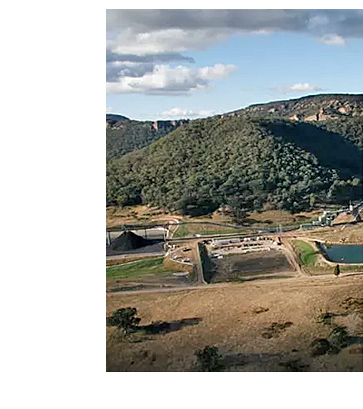Airly

Airly is an underground coal mine located near Capertee, around 40 kilometres northwest of Lithgow.
Operating since 2009, Airly employs 130 people and produces up to 1.8 million tonnes of coal annually, predominantly for the domestic market.
Read about Airly Mine Subsidence Management and Monitoring.
Tel: +61 2 6359 2100
Airly community information and complaints*: +61 2 6359 2108
Email: info.airly@centennialcoal.com.au
We operate our mines to minimise the environmental footprint, however, we welcome any enquiries and feedback from the community and make a commitment to respond promptly.
Document Type Overview
Community Consultative Committee
A Community Consultative Committee (CCC) provides a forum for open discussion between representatives of the Company, community, council and other stakeholders on issues directly relating to the mine’s operations, environmental performance and community relations, and keeps the community informed on these matters.
Airly’s Community Consultative Committee is called a Special Monitoring Committee (SMC). To view the SMC minutes please click on Community Consultative Committee document type below.
Environment Protection Licence
To view the Airly EPL, visit the NSW Environment Protection Authority website.
Environmental Protection and Biodiversity Conservation (EPBC)
The Environment Protection and Biodiversity Conservation (EPBC) Act is administered by the Federal Government’s Department of Environment, which is incorporated into the Department of Sustainability, Environment, Water, Populations and Communities.
The EPBC Act requires any person who proposes to undertake an action that will have, or is likely to have, a significant impact on a matter of national environmental significance to refer that action to the Minister for a decision as to whether assessment and approval is required under the EPBC Act. This decision is referred to as a ‘controlled action’. Where it is deemed a controlled action, the Minister may approve the action and issue conditions of approval.
Environmental Assessments
Environmental Assessments (EAs) are an assessment of the environmental, social and economic benefits and impacts of a proposed project or modification to an existing project. EAs are regulated by the NSW Department of Planning and Infrastructure.
Environmental Management
Approvals obtained to facilitate mining generally require management plans in consideration of various identified environmental impacts. These plans vary from operation to operation to reflect the operating conditions.
Rehabilitation Management Plan
All mines in New South Wales are required to conduct rehabilitation planning, risk assessment and annual reporting on progressive rehabilitation activities as part of their standard mining lease conditions.
The Rehabilitation Management Plan (RMP) has been prepared in accordance with the NSW Resources Regulator’s Form and Way: Rehabilitation Management Plan, as associated with the Mining Amendment (Standard Conditions of Mining Leases – Rehabilitation) Regulation 2021.
The RMP describes how the leaseholder proposes to manage all aspects of rehabilitation. It includes a description of proposed steps and actions, risk assessment, control measures, outcomes for the rehabilitation areas and how success against these outcomes is to be measured.
Pollution Incident Response Management Plan
The Pollution Incident Response Management Plan has been developed to satisfy the requirements of the Protection of the Environment Legislation Amendment Act 2011 (POELA Act), which requires the preparation, implementation and publication of a Pollution Incident Response Management Plan.
The objectives of these plans are to provide guidelines and procedures for the effective control and reporting of pollution incidents to all relevant stakeholders.
While personal contact details for the following document are available in the controlled on-site Pollution Incident Response Management Plan, they do not appear in this public document under provision of the Privacy and Personal Information Protection Act 1998.
Subsidence Management
Subsidence Management Plans (SMPs) are prepared by mining lease holders to consider the potential impacts of underground mining and identify measures to manage such impacts. SMPs may contain requirements for the avoidance of damage to particularly significant features, the mitigation of damage, or rehabilitation of subsidence related impacts.
Environmental Reporting & Compliance
Provides a summary of environmental monitoring data undertaken as required by Environment Protection Licences and Approvals. The purpose of this data is to provide the community with meaningful information on the performance of environmental controls.
Independent Environmental Audits
Independent Environmental Audits are undertaken regularly as a component of each mining approval. The audit is undertaken by a suitably qualified independent expert. The purpose of the audit is to independently assess the environmental performance of the mine and whether it is complying with the relevant requirements of its project approval, any relevant mining lease and environmental protection licence.
Site Operation Documents
Centennial Coal Document PortalPagination
- Page 1
- Next page
